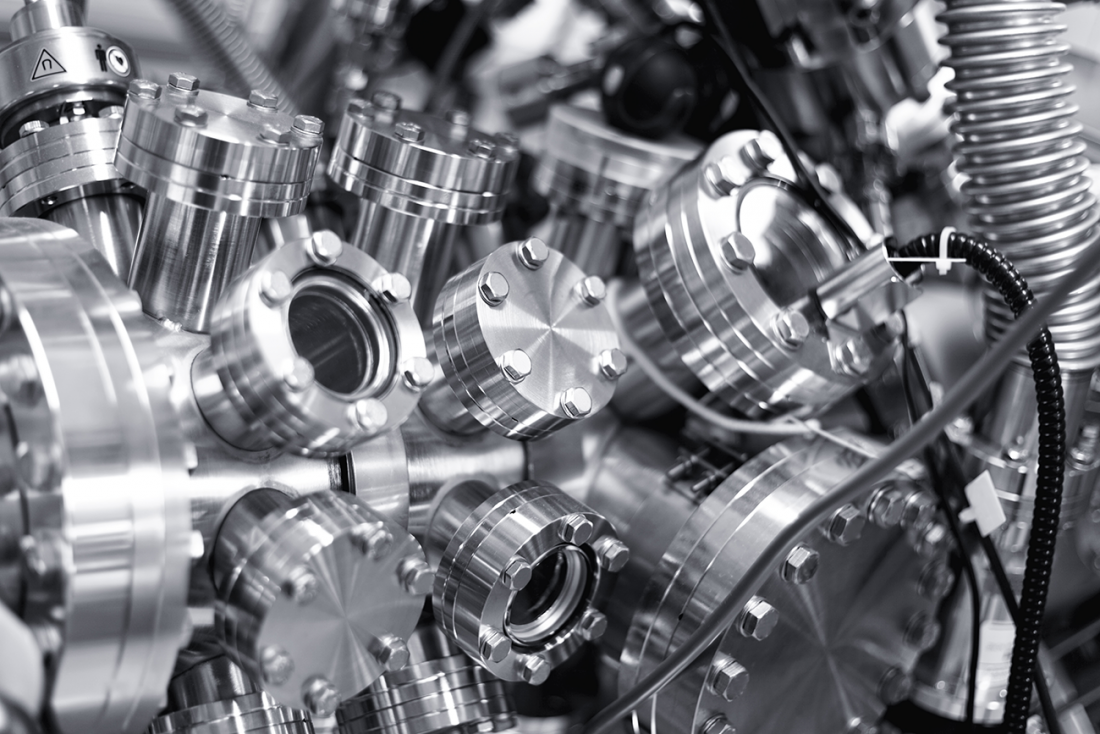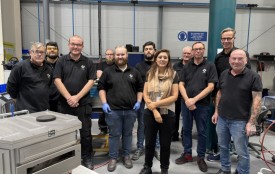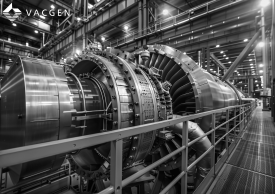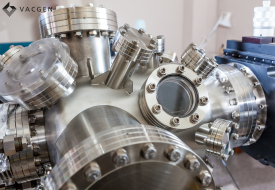VACGEN’s ultra-high vacuum chambers are used throughout research and industry, with each sector leveraging advanced builds and technology to suit their unique needs.
If you need a vacuum chamber solution to suit your precise application, the team at VACGEN are the experts you’re looking for – but if you’d like to learn a little more about the typical applications of our chambers first, please read on.
1 - Semiconductor Applications
Often required for deposition, etching or wafer transfer, the semi-conductor industry require copy exact builds which can withstand multiple processes. For this reason, the silicon wafers inside each chamber are developed in a multi-stage procedure, within a stainless-steel or aluminium enclosure.
Some chambers are fitted with LN2 cooling around the exterior of the build or have a complete internal cryo shield, providing consistent cooling to the vacuum chamber and a controlled environment for the semiconductor processing. In the majority of cases, these chambers are machined from solid aluminium. In all cases the chambers must be diligently cleaned free from any leaks or contaminants.
2 - MBE Applications
Molecular beam epitaxy (MBE) is often used in material deposition and OEM science for developing new materials.
MBE is a material growth technique which uses a refined form of vacuum evaporation or physical vapor deposition. It allows for high control over material purity, interface formation, alloy compositions and doping concentrations.
MBE typically requires the very best vacuum pressures - 1x10-10. mbar as a base pressure.To achieve these consistent pressures within the chambers, they are routinely baked during operation. For this reason, chambers are fitted with extremely durable 316LN flanges that can withstand the multiple bake cycles. The 316LN material is essential to ensure the knife edge of the flange does not soften during the repeated bake-outs.
MBE chambers can also be designed and manufactured with an internal cryo-shield. This acts as a pump, constantly improving the vacuum. When manufacturing the cryo-shield, the welding of must be indefectible – as not only must it withstand the multiple bake cycles described above, but LN2 cold cycles as well.
3 - XPS Applications
XPS (lab-based x-ray photoelectron spectroscopy) is often used in materials analysis and synchrotron processes.
XPS is a technique for analysing a material's surface chemistry. It can measure elemental composition as well as the chemical and electronic state of the atoms within a material.
Photoelectron spectroscopy chambers are often manufactured using mu-metal, which shields the analysis position from the Earth’s magnetic field. When a chamber is fabricated from solid mu-metal, there is less internal surface area (when compared to inserting a liner) and therefore vacuum performance is generally better. During the manufacturing process, a mu-metal chamber will be brazed. This means the whole chamber is baked to high temperatures under vacuum, driving out any remaining hydrogen atoms to and leaving a clean internal surface.
4 - ARPES Applications
As above, ARPES (angle-resolved photoemission spectroscopy) is often used in materials analysis and synchrotrons.
An often-experimental technique, ARPES uses a photon source to probe the allowed energy and forces of electrons in a material (usually a crystalline solid).
ARPES systems use a monochromatic light source to deliver a narrow beam of photons into a sample holder connected to a manipulator (used to position the sample of a material) and an electron spectrometer. The equipment is contained in an ultra-high vacuum environment, which protects the sample and prevents scattering of the emitted electrons.
To use synchrotrons as an example, the incoming energy can vary between 10ev (ARPES) to 1486ev (Al k alpha XPS) and up to 10Kev (HAXPS). Photoelectron spectroscopy which is undertaken in a synchrotron will typically require a stainless-steel chamber lined with mu-metal.
These chambers are usually a bell jar shape and contain one or two mu-metal liners, depending on the x-ray source energy and amount of magnetic screening required.
Mu-metal liners are used inside the stainless-steel body for magnetic shielding against the Earth’s natural magnetic forces, as the liners allow for less external stress on the walls of the chamber. For better magnetic screening, more than one liner would be needed in some cases.
5 - PLD/PVD Applications
Pulsed Laser Deposition and Physical Vapor Deposition (PVD) are also used in material deposition and OEM science.
This technique uses a high-powered laser, focused inside a vacuum chamber, to strike a target of the material to be deposited. This material is then vaporised from the target in a plasma plume, which deposits a thin film on a substrate.
This process can occur in ultra-high vacuum, or in the presence of a background gas, such as oxygen (which is commonly used when depositing oxides, to fully oxygenate the deposited films). Chambers are often built from stainless steel and come in a number of different shapes and sizes to accommodate the size, shape and quantity of the parts needed to be quoted. PVD chambers are often provided with a large entry door to provide quick access for the loading and unloading of materials.
6 - Mass Spectrometry
Mass spectroscopy covers a number of different applications, one example would be Secondary Ion Mass Spectrometry (SIMS) which is used for materials analysis.
The SIMS technique is used to analyse the composition of solid surfaces and thin films. A focused primary ion beam is used to sputter the surface of a specimen, so the ejected secondary ions can be collected and examined.
During SIMS, the sample is ionized under high-energy conditions to produce the molecular ion (M+). The aim is to control the paths of ions using magnetic fields within the flight tubes.
Vaporised and ionised molecules are accelerated through an electric field, down the flight tube and onto the detector.
There are four main stages in a mass spectrometer which need to be considered:
- Ionisation (Source chambers)
- Acceleration (Lens Chambers)
- Deflection (Flight tube chambers)
- Detection. (Detector Chambers)
The type of mass spectrometry you are performing will depend on the type of chamber required.
Flight tubes in which the ions are guided for lab-based systems can be manufactured from stainless steel. These can be difficult to produce, as they need to be very low profile to fit between the magnets. Often, lab-based mass spectrometry analysis chambers are made from solid, machined aluminium. In many cases for mass spectrometry you require very low back ground gases so the vacuum conditions need to be optimised to enable you to measure the required masses which may be disguised by elevated backgrounds. In all cases the chambers must be diligently cleaned free from any leaks or contaminants.
You’ll find these ultra-high vacuum applications in advanced industries such as:
- Semiconductor
- Scientific Instrument Manufacturing
- Research Laboratories
- Energy
- Medical
- Defence
Our manufacturing capabilities include:
- 5 axis CNC
- Milling Turning and Boring
- Tapping and Threading
- 3D CAD and CAM
- Rolling, Milling, Drilling and Reaming.
If you need vacuum technology to support your manufacturing, testing or research environment, VACGEN are here to help. We create advanced vacuum solutions for even the most complex applications.
Do you have a project that you’d like to discuss? Our expert team is ready to help. Get in touch today








